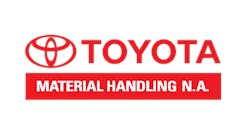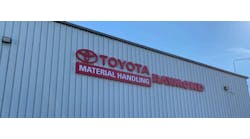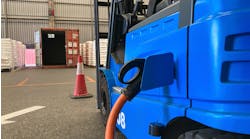The Human Element Is the Key Ingredient in Forklift Safety
No matter the industry, it seems that technology continues to move ever more swiftly. Each June, as the material handling industry focuses on the importance of forklift safety on National Forklift Safety Day, attention often turns toward the latest technologies that can help maintain and strengthen a healthy safety culture, giving forklift operators the tools, training, feedback and confidence they need to do their jobs more proficiently.
There are technologies available today that simply didn’t exist, even just a few short years ago. For instance, a growing number of operator assist technologies can help operators prioritize safety and overcome the challenges of today’s dynamic supply chains. Proximity assist technology is one example. It uses LiDAR sensors installed on the forklift to scan for objects in the path of the forklift, alert the operator of their presence and actively slow the vehicle.
Telematics systems can also play a vital role in enhancing safety by providing insight concerning equipment performance, operator behavior and safety procedures. These systems can provide real-time feedback that reinforces correct behavior and alerts operators to incorrect behavior. They can also help ensure operators properly complete pre-shift inspections by providing visual guidance regarding the components and systems to be reviewed.
These are just some of the technologies that can be valuable additions to any forklift safety and/or training program. However, operators and supervisors need to remember that while these technologies can play a vital role in enhancing safety, they are just one component of a comprehensive safety program. Technology is an important tool in your safety toolbox, but operators, supervisors, trainers and warehouse personnel all bear responsibility for encouraging and enforcing workplace safety.
Operator assist technologies are vital enhancements, but without human vigilance, they can create a false sense of security when it comes to forklift safety. Operators and/or supervisors may be less attentive, thinking the technology will help mitigate safety concerns. Complacency may set in, increasing the risk for accidents and safety issues. At the end of the day, a successful safety program still depends on the right operator behavior and the tried-and-true fundamentals of forklift safety.
Regardless of how much advanced forklift technology you have deployed, emphasizing safety fundamentals is still vital to an effective safety program. This is even more important as the supply chain environment has become more dynamic and workforce challenges are introducing newer, less experienced operators to the workplace.
Following are four tips to help ensure your operation continues to focus on the fundamentals of forklift safety.
1. Identify the Limitations of Your Safety Technologies
To enhance forklift safety, you must identify the limitations of the technologies you have deployed. These limitations are not the result of poor design but rather the inherent limitations of today’s technology. They exist to enhance the capabilities of the operator, not to replace him or her.
Once you’ve identified the limitations, you need to understand how the human element can compensate for them. For instance, some telematics systems can tell you when and where a forklift impact occurs, but they cannot tell you why or prevent it from happening again. Operators and warehouse personnel need to evaluate the data and determine the right corrective action.
2. Train Your Supervisors to be Safety Stewards
Supervisors play a vital role in warehouse operations and that role should extend to helping operators apply their training on the job to help ensure a safe working environment. Your supervisors should be trained to spot at-risk behaviors and environmental hazards, provide positive and constructive feedback, and understand the basics of OSHA’s regulations governing powered industrial trucks.
Let’s look again at forklift impacts. If you have a telematic system to alert you to impact events, a properly trained supervisor can then look at the data and determine an effective course of action to eliminate the issue or minimize the risk. Is it one or two operators who may benefit from one-on-one coaching? Is it a specific portion of the warehouse layout that may be causing the issue? In some cases, it may be a more significant issue that could be fixed with changes to existing operator training programs.
3. Reinforce Environmental Awareness with Your Forklift Operators
When driving forklifts, operators need to maintain 360° environmental awareness. They must pay attention to their surroundings and maintain operational control to react accordingly. Many safety-related technologies—such as LiDAR sensors that scan for objects, pedestrians and other forklifts—are designed to operate in one horizontal plane. For instance, they may not be capable of identifying multiple hazards ranging from slippery spots on the floor to overhead obstructions that limit lift height.
Many of these technologies are pre-programmed to work in controlled, often restricted, environments while today’s warehouse can be a dynamic or even chaotic environment. When an operator drives the forklift outside of a more controlled environment or deviates from the daily routine, the technology may not be capable of exhibiting the same level of functionality.
4. Ensure Your Operators Understand All the Forklifts They Drive
Traditionally, an operator would drive one type of forklift (e.g., stockpicker, counterbalance), becoming familiar with the lift truck over time and understanding its capabilities. As many companies are challenged to fill every warehouse position, this is not always the case. It is more common today for operators to drive multiple types of forklifts across different applications during a shift.
When your operators move from one kind of forklift to another, they need to be trained to understand what is different about the lift truck and how it may operate differently in various scenarios. For example, some differences may include how the forklift behaves with a full load and the stopping distance required. OSHA 1910.178(I)(2) provides more information about training requirements for specific forklift types.
No matter the technology you’ve incorporated into your forklift fleet, it cannot completely address every safety issue, or eliminate every hazard in your environment. While technology has an important role to play, your safety program still depends on a workforce—from warehouse workers to operators and their supervisors—that is properly trained, fully alert and committed to prioritizing safety for themselves, their equipment and the people they work with every day.




